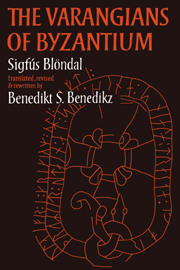Book contents
- Frontmatter
- Contents
- Illustrations
- Preface
- 1 Varangians and their origins
- 2 The army and navy of the High Byzantine Empire
- 3 Norse and Russian forces in the Byzantine army to the death of Romanos III
- 4 Haraldr Sigurðarson and his period as a Varangian in Constantinople, 1034–1043
- 5 The Varangians between 1042 and 1081
- 6 Varangians during the period 1081–1204
- 7 The ghost of the regiment: Varangian evidences 1204–1453
- 8 The Emperor, his Court, his guards and his city
- 9 Some individual Norse and English Varangians and travellers to Byzantium
- 10 Runic inscriptions concerning Varangians
- Select bibliography
- Index
2 - The army and navy of the High Byzantine Empire
Published online by Cambridge University Press: 19 October 2009
- Frontmatter
- Contents
- Illustrations
- Preface
- 1 Varangians and their origins
- 2 The army and navy of the High Byzantine Empire
- 3 Norse and Russian forces in the Byzantine army to the death of Romanos III
- 4 Haraldr Sigurðarson and his period as a Varangian in Constantinople, 1034–1043
- 5 The Varangians between 1042 and 1081
- 6 Varangians during the period 1081–1204
- 7 The ghost of the regiment: Varangian evidences 1204–1453
- 8 The Emperor, his Court, his guards and his city
- 9 Some individual Norse and English Varangians and travellers to Byzantium
- 10 Runic inscriptions concerning Varangians
- Select bibliography
- Index
Summary
The following chapter is by way of a brief introductory sketch to help readers assess the position of the Varangians in the military organization of the Empire, and as such it lays no claim to originality of either information or interpretation.
The military organization of the High Byzantine empire was based on its political division. During our period (from c. 800 onwards) the Empire was divided by themes which, in the reign of Theophilus (829–42) numbered 11 in Asia and 12 in Europe. Each theme provided its corps of soldiers, and the term was sometimes used both of the district and the force supplied by it, the soldiers being known as stratiotai. Two districts, the Cibirriote theme on the South coast of Asia Minor, and the theme of the Islands, were responsible for the provision of the naval force of the Mediterranean fleet. In the frontier districts, moreover, there were garrison forts and heavily fortified mountain passes which were under the military control of the governors of smaller districts, the kleisourai (prob. derived from Lat. clausura). The governors of the larger themes were known as strategoi, and those of the smaller ones as kleisourarchoi, though Italy and Sicily, as long as they were Byzantine provinces (Sicily to 1043, Italy to 1071) were known as katepanata, and their governor as katepano. Military commanders of smaller districts are also found with the titles Dux or Archon.
- Type
- Chapter
- Information
- The Varangians of Byzantium , pp. 15 - 31Publisher: Cambridge University PressPrint publication year: 1979



